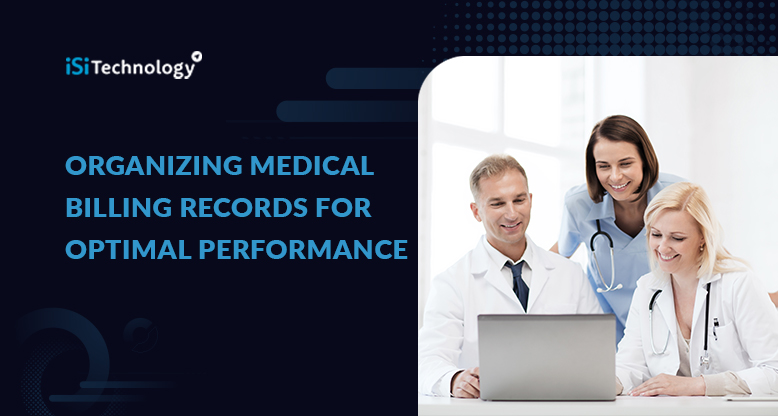Organizing Medical Billing Records for Optimal Performance

Medical billing records are key for accurate and timely payments to service providers in the healthcare industry. But the process of generating them is lengthy and difficult. Regulations on their maintenance can also be tricky. Different laws in different states make the production of medical billing records even more challenging.
In this article, we cover these topics and tell you how medical billing software can make the process of generating medical billing records easier. Let’s dive in and start by defining medical billing.
What is Medical Billing?
Medical billing involves preparing healthcare claims that medical, NEMT (non-emergency medical transportation), and homecare providers submit to insurance companies for service payments. This process converts healthcare services into billing claims so that the service provider gets reimbursed for their work.
What are Medical Billing Records?
Medical billing records are documents that list charges for patient services. These records allow payers and patients to make proper and timely payments to service providers.
Medical billing records typically include copies of the following documents:
- Face-to-face evaluations
- Physician orders
- Assessment records
- Therapy records
- Patient chart records
- Procedure coding sheets
- Referrals
- Prescriptions
- Bills for drugs, services, and other items
Various aspects in the process can quickly become take up a lot of time and become muddled.
About Medical Billing
Medical billing involves:
Front-end Medical Billing
The process for front-end billing begins when patients visit hospitals or doctors’ offices to schedule an appointment. During the pre-registration stage, a member of the administrative staff will help patients fill out forms. They also verify information of patients that typically include:
- Place of residence
- Coverage from insurance
Once the facility confirms that the medical services need by the patient are covered by their insurance policy and the necessary authorizations are obtained, they verify the costs that must be covered by patients. They then inform patients on the expenses they need to shoulder, charge them, and collect the necessary payments.
Upon checkout, a coder converts the records of the patient into codes that are used for billing.
Back-end Medical Billing
Based on instructions from the American Association of Professional Coders or the AAPC, the hospital’s medical coder and back-end medical biller use codes as well as the records of the patient to generate an itemized form referred to as a “superbill.” Healthcare providers use it to file claims. This superbill shows the:
- Details of the provider
- Information of the patient
- Details of the patient’s visit
While preparing claims, a medical biller will scan or “scrub” the claims. The activity boosts the diagnosis’ correctness:
- Diagnosis
- Procedure
- Modifier codes
- Information about the provider, patient, and visit
A medical biller working on the back end will then forward claims to the companies for payment such as clearinghouses. Clearinghouses proceed with scrubbing claims from providers and sending them for settlement. They may also help providers electronically amend and file claims, thereby making errors due to manual processes less likely.
Next, the process of adjudication begins. Payers take a look at the claims and determine provider payments. During this phase, payers can reject, deny, or accept claims.
Payers send Electronic Remittance Advice (ERA) forms back to providers with a list of services that were repaid. In addition, these will mention if they need more details and any causes for rejected and denied claims. Then, Billers will rectify and resend the claims for payment.
When billers receive claim reimbursements, they generate statements of accounts for their patients. Healthcare institutions charge patients any remaining amount that was not qualified for reimbursement, thereby settling what is owed and ensuring maximum revenue.
The last phase in medical billing involves collections from patients. Billers transmit the payments that they got from patients and send them to the accounts receivable management team. This team monitors and records patient payments which complete the medical billing exercise.
Some patients may not settle their bills and may fall into the aging accounts receivable category. This usually happens after 30 days when an account remains unsettled. Billers need to monitor and ask these patients to pay by sending reminders to ensure that the healthcare provider receives what is owed payment without further postponement.
How Long to Keep Medical Billing Records

Different laws mandate healthcare and other service providers to keep a record of billing for different time frames. For instance, the Health Insurance Portability and Accountability Act (HIPAA) asks healthcare associates, providers, and entities to maintain their medical records for a minimum of six years.
Meanwhile, the Centers for Medicare & Medicaid Services (CMS) mandates businesses to store medical records for a minimum of seven years from the Date of Service (DOS).
Various states have their own laws for retaining medical billing records. Factor in federal laws along and state laws where you operate to keep your business legally compliant.
What is NDC in Medical Billing?
The National Drug Code (NDC) is a special code or number with three parts. It helps drug companies classify and monitor drug products that they manufactured or processed.
The Food and Drug Administration (FDA) shares these NDC numbers with healthcare facilities and submits them for listing in the directory of the NDC. This listing data with NDC numbers and the NDC’s directory help enforce the Drug Listing Act of 1972.
The directory is also periodically updated to include drugs that have been recently introduced and approved.
When it comes to medical bills, healthcare claims often use NDCs. NDCs encourage optimized billing of administered drugs while maintaining accuracy and transparency in payments. The process helps maximize revenue generation for different providers.
Medical Bills and the Global Period
The global surgery field promotes postoperative time frames applicable to paid amounts for surgical treatments. When it comes to medical billing, global periods begin on the day of the procedure and becomes final a few days later. It essentially encompasses the stay of a patient in a hospital or a clinic’s postoperative care facility.
Based on the time frame that’s covered by after the operation, the global period has three phases that may be zero days, 10 days, and 90 days.
Medical billing involves the generation of bills for global operation packages that’s assisted by certain surgical codes and combinations. It helps companies’ collect full reimbursement during the global period by preventing late payment.
Why Medical Billing Software is Important When Maintaining Billing Records for Medical Purposes

Activities involving the generation of medical billing records from start to end is complex and lengthy. This is where software for medical billing can help a lot.
Using advanced software, healthcare and allied service providers can conduct faster billing while having opportunities to correct medical billing errors. This reduces the amount of healthcare claims that are not accepted. Additionally, it boosts the efficiency of accounts receivable management. This encompasses the productivity of the staff and workflow management.
This aids revenue generation which covers and optimizes medical billing software costs.
Final Thoughts: ISI Technology, Medical Billing Made Easier
Medical billing records are essential to the healthcare sector’s daily operations. They help businesses promptly receive their reimbursements.
Are you still using manual routes for filing healthcare claims? It may be time to explore medical billing software solutions. They help you instantly file error-free claims while helping you receive timely reimbursements.
You can also get access to automatic claim data downloads and imports, customized reports, and other advanced features and tools. This will help you optimize your operations and make your business leaner and more agile.
ISI Technology offers a wide range of impressive billing solutions. It includes Medicaid billing software, NEMT billing software, and more. If you’d like to check out our software solutions, contact our team for more information.